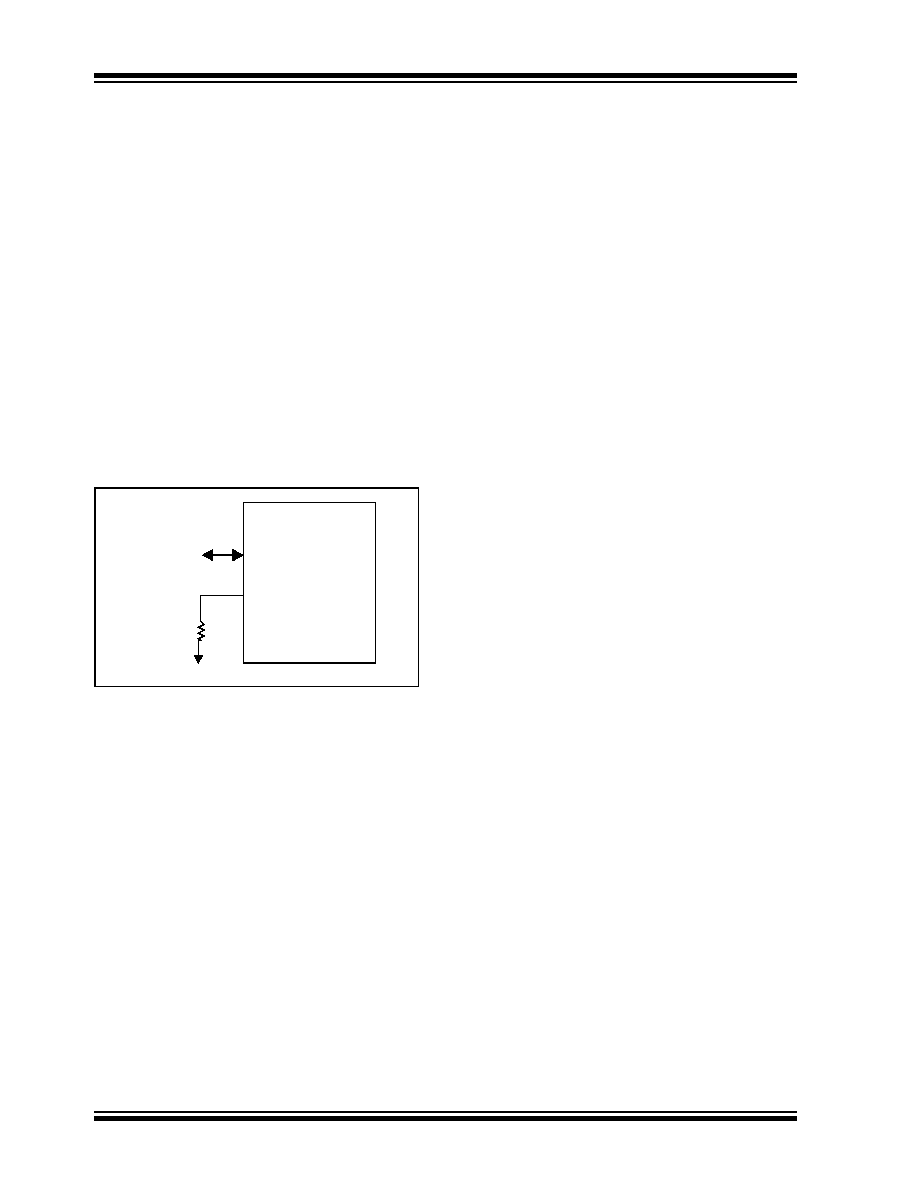- 您现在的位置:买卖IC网 > Sheet目录3890 > PIC16C717T-E/SS (Microchip Technology)IC MCU OTP 2KX14 A/D PWM 20SSOP

PIC16C717/770/771
DS41120B-page 120
2002 Microchip Technology Inc.
12.2.4
ER MODE
For timing insensitive applications, the ER (External
Resistor) Clock mode offers additional cost savings.
Only one external component, a resistor connected to
the OSC1 pin and VSS, is needed to set the operating
frequency of the internal oscillator. The resistor draws
a DC bias current which controls the oscillation fre-
quency. In addition to the resistance value, the oscilla-
tor frequency will vary from unit to unit, and as a
function of supply voltage and temperature. Since the
controlling parameter is a DC current and not a capac-
itance, the particular package type and lead frame will
not have a significant effect on the resultant frequency.
Figure 12-3 shows how the controlling resistor is con-
nected to the PIC16C717/770/771. For REXT values
below 38 k
, the oscillator operation may become
unstable, or stop completely. For very high REXT values
(e.g. 1M), the oscillator becomes sensitive to noise,
humidity and leakage. Thus, we recommend keeping
REXT between 38 k
and 1 M.
FIGURE 12-3:
EXTERNAL RESISTOR
The Electrical Specification section shows the relation-
ship between the REXT resistance value and the oper-
ating frequency as well as frequency variations due to
operating temperature for given REXT and VDD values.
The ER Oscillator mode has two options that control
the OSC2 pin. The first allows it to be used as a general
purpose I/O port. The other configures the pin as CLK-
OUT. The ER oscillator does not run during RESET.
12.2.5
INTRC MODE
The internal RC oscillator provides a fixed 4 MHz (nom-
inal) system clock at VDD = 5V and 25
°C, see “Electri-
cal Specifications” section for information on variation
over voltage and temperature. The INTRC oscillator
does not run during RESET.
12.2.6
CLKOUT
In the INTRC and ER modes, the PIC16C717/770/771
can be configured to provide a clock out signal by pro-
gramming the configuration word. The oscillator fre-
quency, divided by 4, can be used for test purposes or
to synchronize other logic.
In the INTRC and ER modes, if the CLKOUT output is
enabled, CLKOUT is held low during RESET.
12.2.7
DUAL SPEED OPERATION FOR ER
AND INTRC MODES
A software programmable dual speed oscillator is avail-
able in either ER or INTRC Oscillator modes. This fea-
ture allows the applications to dynamically toggle the
oscillator speed between normal and slow frequencies.
The nominal slow frequency is 37 kHz. In ER mode, the
slow speed operation is fixed and does not vary with
resistor size. Applications that require low current
power savings, but cannot tolerate putting the part into
SLEEP, may use this mode.
The OSCF bit in the PCON register is used to control
Dual
Speed
mode.
See
the
PCON
Register,
Register 2-8, for details.
When changing the INTRC or ER internal oscillator
speed, there is a period of time when the processor is
inactive. When the speed changes from fast to slow,
the processor inactive period is in the range of 100
S
to 300
S. For speed change from slow to fast, the pro-
cessor is in active for 1.25
S to 3.25 S.
RA7/OSC1/CLKIN
RA6/OSC2/CLKOUT
PIC16C717/770/771
REXT
发布紧急采购,3分钟左右您将得到回复。
相关PDF资料
PIC16LC770T-E/SO
IC MCU OTP 2KX14 A/D PWM 20SOIC
PIC16C771T/SO
IC MCU OTP 4KX14 A/D PWM 20SOIC
PIC16LC717T-I/SS
IC MCU OTP 2KX14 A/D PWM 20SSOP
PIC16C717T/SS
IC MCU OTP 2KX14 A/D PWM 20SSOP
PIC16LC770T-I/SO
IC MCU OTP 2KX14 A/D PWM 20SOIC
PIC16LC771T-E/SS
IC MCU OTP 4KX14 A/D PWM 20SSOP
PIC16C771T-E/SS
IC MCU OTP 4KX14 A/D PWM 20SSOP
PIC16LC771T-I/SO
IC MCU OTP 4KX14 A/D PWM 20SOIC
相关代理商/技术参数
PIC16C717T-I/SO
功能描述:8位微控制器 -MCU 3.5KB 256 RAM 16 I/O RoHS:否 制造商:Silicon Labs 核心:8051 处理器系列:C8051F39x 数据总线宽度:8 bit 最大时钟频率:50 MHz 程序存储器大小:16 KB 数据 RAM 大小:1 KB 片上 ADC:Yes 工作电源电压:1.8 V to 3.6 V 工作温度范围:- 40 C to + 105 C 封装 / 箱体:QFN-20 安装风格:SMD/SMT
PIC16C717T-I/SS
功能描述:8位微控制器 -MCU 3.5KB 256 RAM 16 I/O RoHS:否 制造商:Silicon Labs 核心:8051 处理器系列:C8051F39x 数据总线宽度:8 bit 最大时钟频率:50 MHz 程序存储器大小:16 KB 数据 RAM 大小:1 KB 片上 ADC:Yes 工作电源电压:1.8 V to 3.6 V 工作温度范围:- 40 C to + 105 C 封装 / 箱体:QFN-20 安装风格:SMD/SMT
PIC16C71T-04/SO
功能描述:8位微控制器 -MCU 1.75KB 36 RAM 13 I/O 4MHz SOIC18 RoHS:否 制造商:Silicon Labs 核心:8051 处理器系列:C8051F39x 数据总线宽度:8 bit 最大时钟频率:50 MHz 程序存储器大小:16 KB 数据 RAM 大小:1 KB 片上 ADC:Yes 工作电源电压:1.8 V to 3.6 V 工作温度范围:- 40 C to + 105 C 封装 / 箱体:QFN-20 安装风格:SMD/SMT
PIC16C71T-04I/SO
功能描述:8位微控制器 -MCU 1.75KB 36 RAM 13 I/O 4MHz Ind Temp SOIC18 RoHS:否 制造商:Silicon Labs 核心:8051 处理器系列:C8051F39x 数据总线宽度:8 bit 最大时钟频率:50 MHz 程序存储器大小:16 KB 数据 RAM 大小:1 KB 片上 ADC:Yes 工作电源电压:1.8 V to 3.6 V 工作温度范围:- 40 C to + 105 C 封装 / 箱体:QFN-20 安装风格:SMD/SMT
PIC16C71T-20/SO
功能描述:8位微控制器 -MCU 1.75KB 36 RAM 13 I/O RoHS:否 制造商:Silicon Labs 核心:8051 处理器系列:C8051F39x 数据总线宽度:8 bit 最大时钟频率:50 MHz 程序存储器大小:16 KB 数据 RAM 大小:1 KB 片上 ADC:Yes 工作电源电压:1.8 V to 3.6 V 工作温度范围:- 40 C to + 105 C 封装 / 箱体:QFN-20 安装风格:SMD/SMT
PIC16C71T-20I/SO
功能描述:8位微控制器 -MCU 1.75KB 36 RAM 13 I/O RoHS:否 制造商:Silicon Labs 核心:8051 处理器系列:C8051F39x 数据总线宽度:8 bit 最大时钟频率:50 MHz 程序存储器大小:16 KB 数据 RAM 大小:1 KB 片上 ADC:Yes 工作电源电压:1.8 V to 3.6 V 工作温度范围:- 40 C to + 105 C 封装 / 箱体:QFN-20 安装风格:SMD/SMT
PIC16C72/JW
功能描述:8位微控制器 -MCU 3.5KB 128 RAM 22 I/O RoHS:否 制造商:Silicon Labs 核心:8051 处理器系列:C8051F39x 数据总线宽度:8 bit 最大时钟频率:50 MHz 程序存储器大小:16 KB 数据 RAM 大小:1 KB 片上 ADC:Yes 工作电源电压:1.8 V to 3.6 V 工作温度范围:- 40 C to + 105 C 封装 / 箱体:QFN-20 安装风格:SMD/SMT
PIC16C72-04/SO
功能描述:8位微控制器 -MCU 3.5KB 128 RAM 22 I/O RoHS:否 制造商:Silicon Labs 核心:8051 处理器系列:C8051F39x 数据总线宽度:8 bit 最大时钟频率:50 MHz 程序存储器大小:16 KB 数据 RAM 大小:1 KB 片上 ADC:Yes 工作电源电压:1.8 V to 3.6 V 工作温度范围:- 40 C to + 105 C 封装 / 箱体:QFN-20 安装风格:SMD/SMT